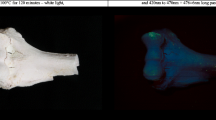Abstract
THE thermoluminescence (TL) of marbles and limestones1–3 from various quarries in Greece4 has been described. It had been hoped that features characteristic of each quarry would be found. The glow curves of samples as taken from the quarry are called natural thermoluminescence curves (NTL). These curves did not allow any determination of origin, because in nearly every case only a single peak was obtained.
Similar content being viewed by others
References
McDougall, D., Thermoluminescence of Geological Materials (Academic Press, 1968).
Goldberg, P., Luminescence of Inorganic Solids (Academic Press, 1966).
Curie, D., Luminescence Cristalline (Dunod, Paris, 1960).
Afordakos, G., thesis, Univ. Athens (1972).
Author information
Authors and Affiliations
Rights and permissions
About this article
Cite this article
AFORDAKOS, G., ALEXOPOULOS, K. & MILIOTIS, D. Using artificial thermoluminescence to reassemble statues from fragments. Nature 250, 47–48 (1974). https://doi.org/10.1038/250047a0
Received:
Revised:
Published:
Issue Date:
DOI: https://doi.org/10.1038/250047a0
- Springer Nature Limited
This article is cited by
-
Die Bestimmung der Herkunft der Marmore von B�sten der M�nchener Residenz
Naturwissenschaften (1980)





